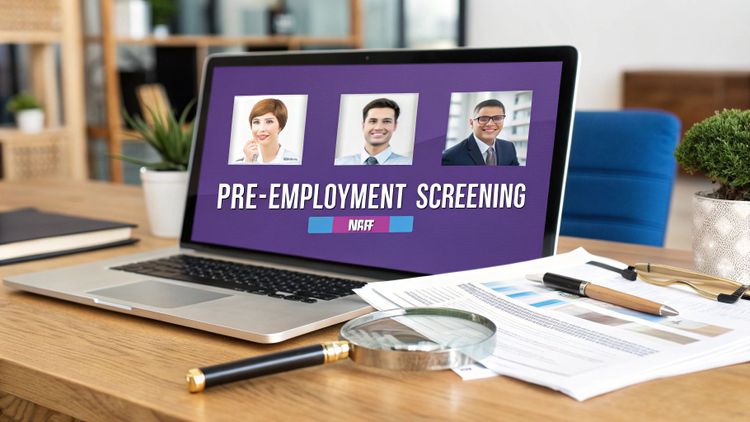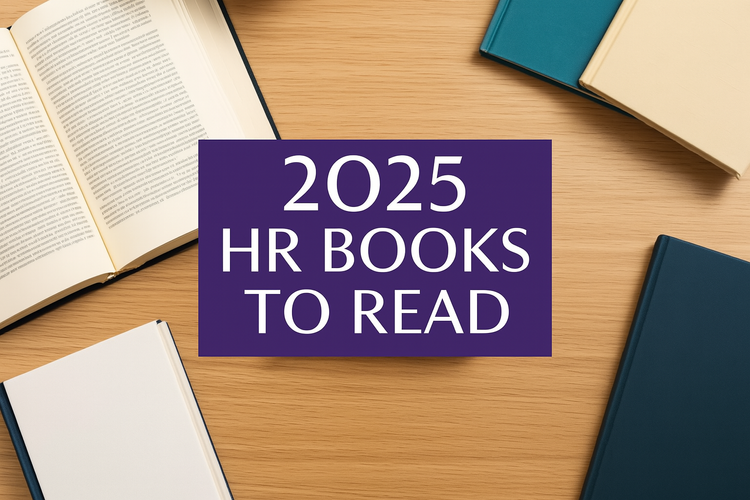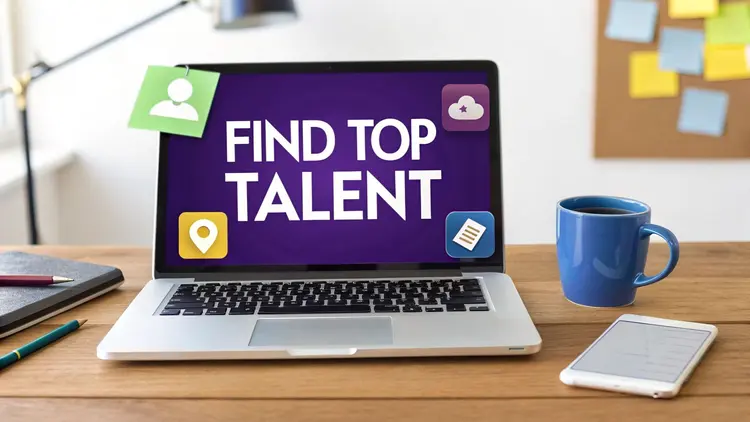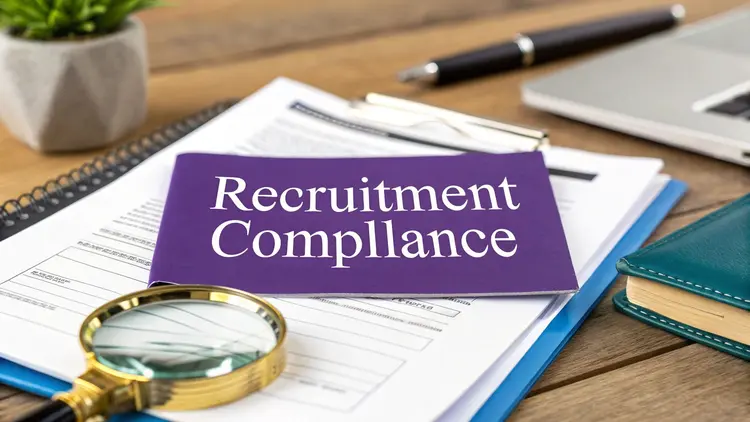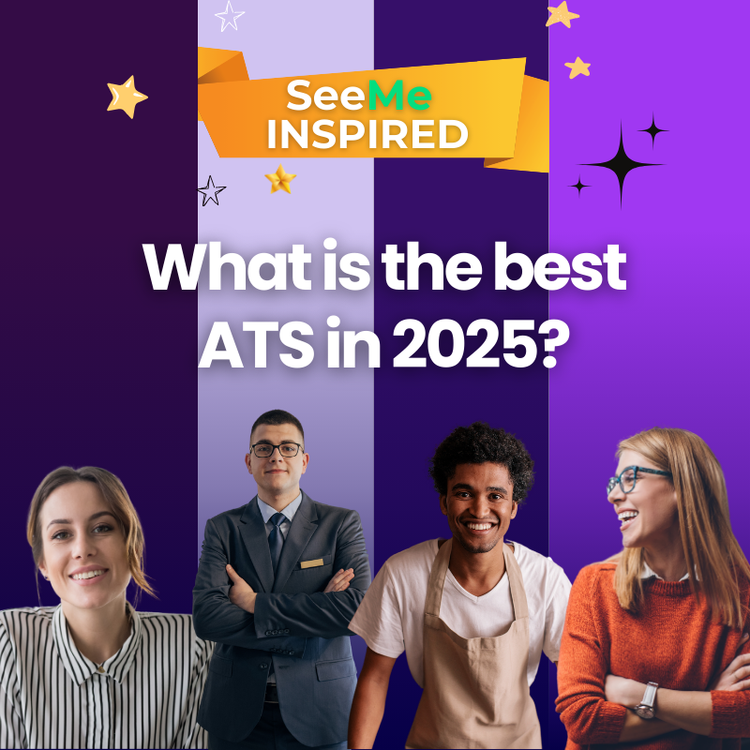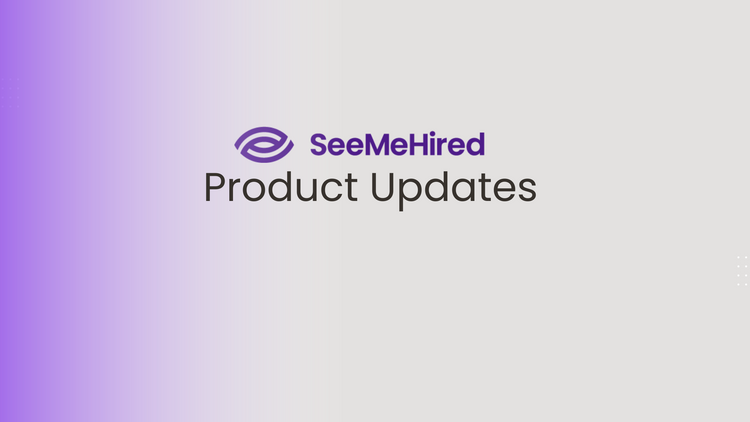SeeMeHired Insights
Skills Based Hiring Modern Recruitment Strategies
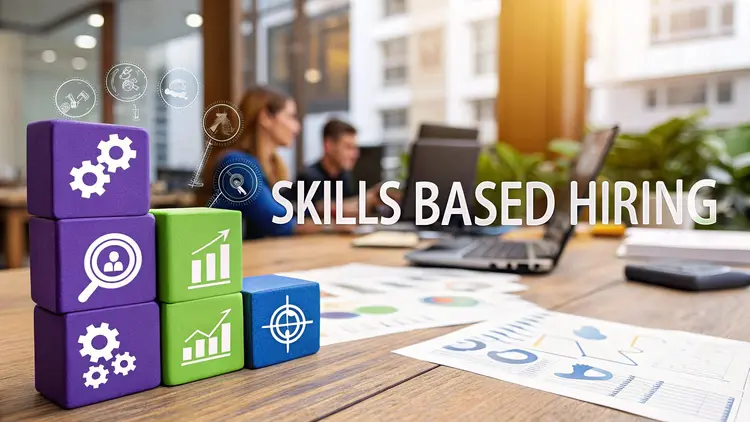
Understanding the True Meaning of Skills-Based Hiring

The term skills-based hiring often appears in HR discussions, but what does it actually mean in practice? At its core, it involves a shift in perspective. Rather than depending on proxies for ability—such as a degree from a particular university, a specific job title, or a set number of years in a position—it concentrates on what a candidate can actually do.
Listen to the Podcast Here:
Consider it similar to assembling a top-tier football team. A manager wouldn’t recruit a new striker solely based on the academy they attended or the number of seasons they’ve played. They would evaluate concrete skills: How accurate is their shot? How swiftly can they move into space? How well do they anticipate the play? Skills-based hiring applies the same logic to the professional world, valuing demonstrable competencies, both technical (hard skills) like coding or data analysis, and behavioural (soft skills) like problem-solving or teamwork.
This approach transforms recruitment from a checkbox exercise into a more precise method of identifying talent. The aim is to answer one essential question: "Does this person have the capabilities required to succeed in this role?" This simple change in focus can open up your recruitment process to a much broader and more diverse pool of candidates.
Moving Beyond the Paper Trail
For years, many job descriptions have acted as strict gatekeepers. Requiring a university degree, for instance, could instantly disqualify a large portion of the available talent, even if that qualification has little bearing on the day-to-day work. With only 36% of the workforce in the US holding a university degree, this practice automatically excludes the majority of potential applicants.
The skills-based model questions this tradition by asking "why?" Why is that degree essential? If the job truly requires someone to manage a budget, isn’t it better to test their financial literacy directly instead of assuming a business degree ensures that skill? This isn’t just a theoretical idea; it’s a practical response to a changing jobs market. This shift is gaining momentum in the UK, where data indicates that by 2025, an impressive 85% of employers planned to prioritise skills over academic history, up from 81% the previous year. You can read the full report on this growing trend from People Management.
To see how these two philosophies compare, let's look at them side-by-side.
| Criteria | Traditional Hiring | Skills-Based Hiring | Impact on Outcomes |
|---|---|---|---|
| Primary Focus | Credentials, years of experience, and past job titles. | Demonstrable skills and abilities, both hard and soft. | Finds talent based on future potential, not just past experience. |
| Candidate Evaluation | CV screening based on keywords and pedigree. | Practical assessments, work samples, and problem-solving tasks. | Provides a more accurate prediction of on-the-job performance. |
| Job Descriptions | Lists degrees and a minimum number of years in a similar role. | Outlines the core competencies and outcomes the role must achieve. | Attracts candidates who have the right skills, regardless of their background. |
| Talent Pool | Often narrowed by arbitrary or outdated requirements. | Widened to include people from non-traditional backgrounds. | Increases diversity and access to a larger pool of qualified candidates. |
| Interview Style | Focuses on discussing past roles and responsibilities. | Uses behavioural and situational questions to assess skills in action. | Gathers evidence of how a candidate thinks and solves problems. |
As the table shows, the main difference is a move from assumption to evidence.
Ultimately, skills-based hiring is about appreciating the whole person. It recognises that valuable skills come from many places—online courses, apprenticeships, personal projects, and on-the-job learning—not just from formal education. By focusing on what people can do, rather than just where they have been, organisations can build more capable, diverse, and forward-thinking teams.
Why Skills-Based Hiring Produces Measurable Results

Adopting a new hiring philosophy is one thing, but seeing it deliver real improvements is what truly counts. Skills-based hiring is more than just a forward-thinking idea; it's a strategic decision that creates clear, tangible outcomes for your business. Companies that prioritise ability over academic history often address some of their most difficult recruitment problems, from talent shortages to high staff turnover.
One of the first and most significant benefits is a much larger talent pool. When you eliminate arbitrary requirements like a university degree, you immediately open the door to a wider, more diverse group of qualified individuals. For example, when one major tech company removed degree requirements for many positions, it saw a 500% increase in applications from candidates with non-traditional backgrounds. This not only makes sourcing easier but also brings a richer variety of perspectives into your organisation. If you're looking to expand your own reach, our guide on how to source more and better candidates with LinkedIn offers practical advice.
Enhancing Retention and Performance
The positive effects of skills-based hiring extend well beyond the recruitment stage. When people are hired for what they can actually do, they are more likely to be a great fit for their roles. This alignment leads to higher job satisfaction and engagement, which is directly linked to better retention rates. In fact, research indicates that 94% of companies found employees hired using skills-based methods performed better than those selected based on traditional CVs.
This improved performance occurs because the hiring process is a more accurate forecast of on-the-job success. Instead of using a CV as a stand-in for competence, skills-based approaches involve practical assessments and work simulations. Think of it like giving a chef a basket of ingredients and asking them to create a dish, rather than just asking to see their culinary school diploma. You get a much clearer picture of their real abilities, leading to hires who can contribute meaningfully from their first day.
The Financial Justification for a Skills-First Approach
Ultimately, these improvements in recruitment and performance lead to considerable financial benefits. A shorter time-to-hire means less lost productivity from vacant roles. Better retention reduces the significant costs tied to recruiting, hiring, and training new staff.
Furthermore, a more capable and diverse workforce is better prepared to drive innovation and business growth. One financial services firm calculated that shifting to skills-based hiring resulted in a 30% reduction in onboarding time, saving thousands on each new employee. By concentrating on what candidates can do, organisations build more resilient, adaptable, and high-performing teams, showing that this approach is not just an HR trend but a solid business strategy.
Navigating the Changing Skills Landscape

The skills organisations need most are changing faster than ever before. This constant shift is a key reason why skills-based hiring has moved to the forefront of modern recruitment. Think of it like a ship's captain navigating the open sea; you must constantly read the weather to adjust your course, avoiding storms and catching favourable winds. Today, those winds are driven by technology like automation and artificial intelligence (AI), which are reshaping jobs in every industry.
This wave of technology isn't just about replacing old roles; it's about transforming them. While some routine tasks can now be automated, new roles are appearing that require a combination of technical ability and human creativity. This creates a fascinating situation: as our tools become smarter, distinctly human qualities like critical thinking, problem-solving, and emotional intelligence become even more valuable. In this new work environment, adaptability and a commitment to lifelong learning are essential.
Future-Proofing Your Hiring Criteria
To make skills-based hiring work, you need to learn to separate essential requirements from outdated habits. Imagine packing for a long trip with limited luggage space. You have to decide what’s absolutely necessary (your passport, suitable clothes) and what’s merely nice to have (a fourth pair of shoes). Your job descriptions should follow the same logic, focusing only on what truly matters for the role.
Here’s a practical way to approach this:
Identify Core Competencies: Start by asking what the person in this role must achieve. Will they manage a budget, collaborate with a diverse team, or analyse complex data? The answers define the role's core competencies.
Separate Skills from Credentials: Once you know the competencies, pinpoint the specific skills needed to deliver them. For example, instead of asking for a "Marketing Degree," focus on skills like "digital campaign analysis" or "content creation." This adjustment opens your talent pool to candidates who gained skills through experience, not just formal education.
Prioritise Transferable Skills: Look for abilities that are valuable in any context, such as project management, problem-solving, and clear communication. These skills show a candidate's potential to grow and adapt, helping future-proof your team against whatever changes come next.
The Impact of AI and the Skills Gap
The growth of AI is accelerating this transformation. In the UK, demand for technology-related skills is climbing as businesses adapt. Between 2018 and 2024, job postings that mentioned AI skills shot up by an incredible 3,355%. This increase shows how quickly market needs are changing and why a rigid, degree-focused hiring approach is no longer effective. You can discover more insights on the state of skills-based hiring in 2025 to get a fuller understanding of these trends.
This rapid change also contributes to a growing skills gap, where businesses struggle to find people with the specific abilities they need. Forward-thinking companies are tackling this by changing their mindset. Instead of searching for the "perfect" candidate who ticks every box, they are identifying people with strong foundational skills and the ability to learn. They are choosing to develop talent from within, a strategy that skills-based hiring is perfectly designed to support. As you explore these strategies, it's also crucial to stay compliant with data protection laws, as detailed in our essential guide on GDPR in recruitment for UK teams.
The Role of Soft Skills in Transforming Recruitment
While technical abilities are the building blocks, the true power of skills-based hiring comes alive when we consider soft skills. These interpersonal qualities—like communication, collaboration, and emotional intelligence—are vital to a thriving team. Think of it like this: a team of brilliant programmers who can’t communicate their ideas or work together is like a high-performance engine with no oil. All that technical power is wasted. In contrast, a team that blends technical expertise with strong soft skills can overcome complex challenges and drive real progress. This is why these once-overlooked qualities are now central to hiring decisions across all industries.
The right balance between hard and soft skills is becoming a key advantage for successful organisations. This is especially true in the UK tech sector, often mistakenly seen as valuing only technical expertise. In reality, a 2025 report found that 74% of UK tech firms would choose soft skills over hard skills when recruiting. This highlights a clear understanding that a candidate's ability to collaborate, adapt, and lead is just as important as their ability to code. You can learn more about the tech industry's growing emphasis on soft skills to see how this trend is reshaping recruitment.
How to Measure the Unmeasurable
One of the biggest challenges in skills-based hiring is finding a way to objectively assess subjective traits like creativity or resilience. The solution is to shift from asking abstract questions to observing behaviour. Instead of asking, "Are you a good problem-solver?" you can design a scenario that puts that very skill to the test.
Here are some effective methods for evaluating soft skills:
Behavioural Interviews: These interviews are built on the premise that past actions predict future performance. Questions like, "Tell me about a time you had to persuade a sceptical colleague," require candidates to share concrete evidence of their skills.
Situational Assessments: Present candidates with a realistic, hypothetical work challenge. This could be anything from dealing with a difficult client to managing a project with a sudden change in scope. Their response reveals their problem-solving approach and interpersonal abilities.
Collaborative Work Samples: For roles where teamwork is essential, assign a small group task during the interview process. Watching how candidates interact, share ideas, and resolve disagreements offers direct insight into their collaborative skills.
By creating these structured evaluations, you establish a consistent framework for your entire hiring team. This method helps to replace gut feelings with evidence-based assessments, leading to fairer and more reliable hiring choices. Building a solid evaluation process is a cornerstone of any effective recruitment strategy, and our guide offers 8 ways to improve your candidate selection process with more practical tips. By consistently measuring these crucial soft skills, you can find candidates who will not only excel in their roles but also enrich your company culture.
Implementing Skills-Based Hiring Step by Step
Making the switch to skills-based hiring can seem like a major project, but when broken into manageable steps, it becomes achievable for any organisation. This isn't about overhauling your entire recruitment process overnight. Instead, view it as a series of deliberate upgrades, each building on the last to create a more effective, fair, and evidence-based system for finding talent. The journey begins not with candidates, but with a deep dive into your own operational needs.
The following infographic shows the essential flow of this process, outlining three foundational steps to get you started.
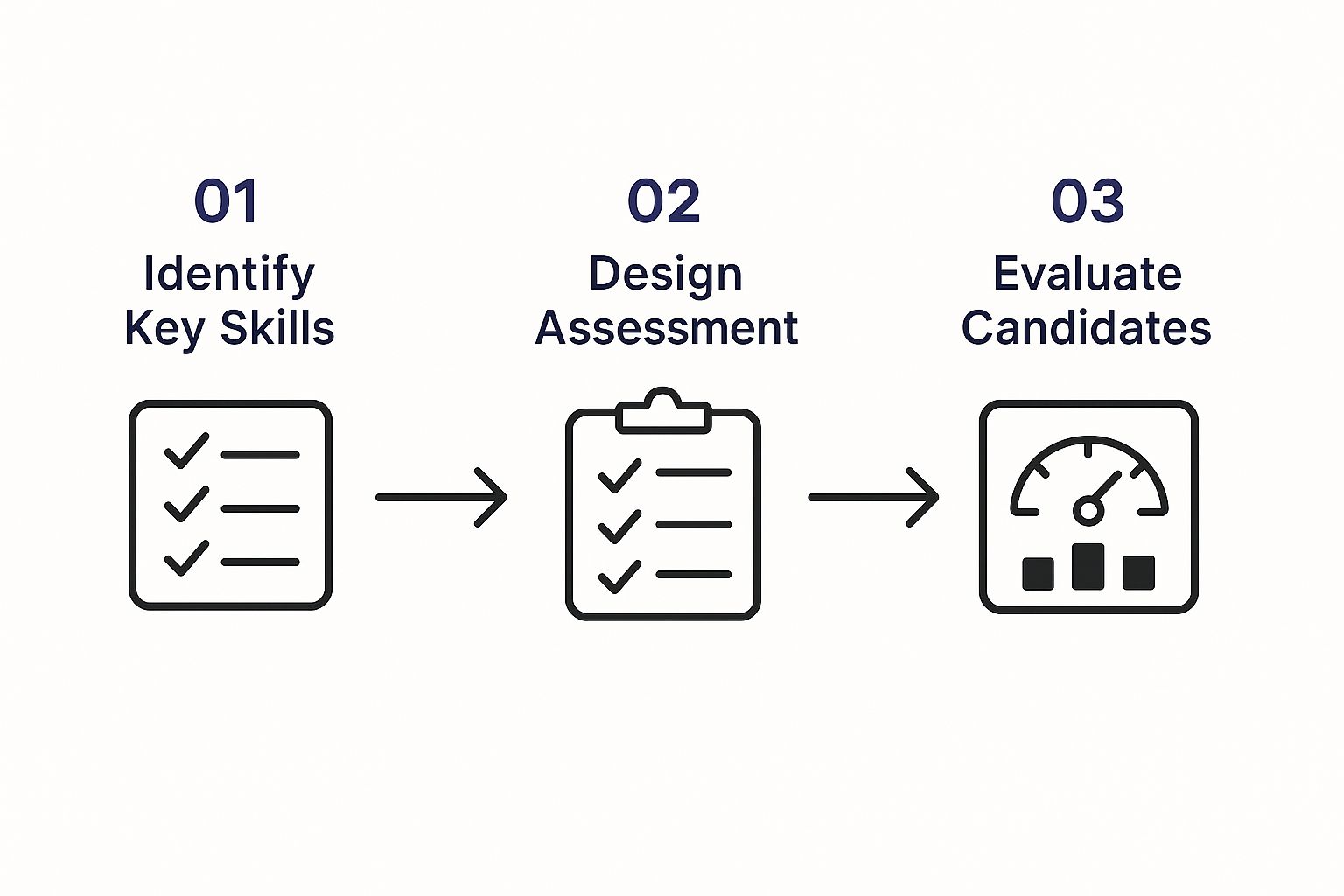
As the graphic illustrates, a successful skills-based approach starts by clearly identifying the required skills before you even think about writing a job advert. From there, you can design relevant assessments and finally evaluate candidates against those defined benchmarks.
Phase 1: Identify and Map Core Competencies
The first step is to carry out a skills audit. Before you can find the right people, you must clearly define what "right" looks like for each specific role. This involves looking past outdated job descriptions and focusing on the actual outcomes you need.
Analyse High Performers: Examine the most successful people currently in the role. What specific skills—both technical and behavioural—do they use to get great results? Are they exceptional problem-solvers, clear communicators, or masters of a particular piece of software?
Consult with Team Leaders: Speak directly with hiring managers to understand the real-world challenges a new hire will face. Ask them, "What problems will this person need to solve in their first six months?" This shifts the focus from paper qualifications to practical capabilities.
Distinguish Must-Haves from Nice-to-Haves: Create a clear hierarchy of skills. For a data analyst role, proficiency in SQL might be a non-negotiable must-have, whereas experience with a specific visualisation tool like Tableau could be a desirable nice-to-have. This simple act prevents you from unintentionally filtering out a great candidate who could learn a new tool in a week.
Phase 2: Redesign Your Job Adverts and Sourcing Strategy
With your skills map complete, it's time to rewrite your job descriptions to reflect this new emphasis. Your job advert is your main tool for attracting the right people, so the language you use is incredibly important.
Focus on 'What You'll Do,' Not 'What You Have': Frame the role around actions and responsibilities. Instead of listing "Requires a bachelor's degree and 5+ years of experience," try something like, "You'll be responsible for managing project budgets and leading a team of three to deliver on quarterly goals."
Use Inclusive Language: Remove corporate jargon and overly formal language that might deter qualified individuals. The aim is to invite applications from anyone who has the necessary skills, no matter how or where they acquired them.
Expand Your Sourcing Channels: A skills-first mindset naturally broadens your talent pool. Look beyond traditional job boards to communities, online forums, and organisations that connect with talent from non-traditional backgrounds.
Phase 3: Restructure Interviews and Assessments
This is where you gather the proof. The interview process must be re-engineered to accurately measure the core competencies you identified in the first phase.
Implement Practical Assessments: Move beyond just talking and ask candidates to demonstrate their skills. This could be a short coding challenge, a case study analysis, a writing sample, or a presentation on a relevant topic. These work samples are highly predictive of on-the-job performance. In fact, 90% of companies reported making better hires when they focused on skills over degrees.
Use Structured, Behavioural Questions: Equip your interviewers with a consistent set of questions designed to explore specific skills. For example, to assess collaboration, you could ask, "Tell me about a time you worked on a team project that hit a major obstacle. What was your role, and how did you help get it back on track?"
Create a Standardised Scoring Rubric: To reduce bias and ensure fairness, evaluate all candidates against the same predefined criteria. A simple rubric that scores candidates on each key skill (e.g., from 1 to 5) helps hiring managers make objective, data-driven decisions instead of relying on gut feelings.
To help you plan your transition, the table below offers a sample timeline for putting these practices into action.
| Phase | Duration | Key Activities | Success Metrics |
|---|---|---|---|
| Phase 1: Foundation & Planning | 2-4 Weeks | Conduct skills audits for pilot roles. Train hiring managers on skills-first principles. Define core competencies for each role. | At least 3 pilot roles have defined skills maps. 90% of relevant hiring managers complete training. |
| Phase 2: Process Redesign | 4-6 Weeks | Rewrite job description templates. Develop new interview questions and scoring rubrics. Create practical assessment tasks. | New templates are used for all pilot roles. Standardised rubrics are available for pilot roles. |
| Phase 3: Pilot Implementation | 6-8 Weeks | Post new job adverts for pilot roles. Conduct structured interviews and assessments. Gather feedback from candidates and hiring teams. | Time-to-hire for pilot roles meets or beats baseline. Offer acceptance rate for pilot roles is >85%. |
| Phase 4: Review & Roll-out | 2-4 Weeks | Analyse pilot data (quality of hire, diversity metrics). Refine processes based on feedback. Develop a plan for organisation-wide implementation. | Quality of hire score improves by 15%. A clear plan for company-wide adoption is approved. |
This timeline shows that a phased approach, starting with a pilot programme, is a practical way to manage change and demonstrate value before a full-scale roll-out.
Successfully implementing these steps is a team effort, and a well-planned strategy can make all the difference. For more ideas on how to refine your overall approach, check out our guide on 10 ways to optimise your recruitment strategy. By methodically building your skills-based hiring framework, you create a more resilient and effective way to build a talented team.
Overcoming Implementation Roadblocks
Switching to a skills-based hiring model is a great idea on paper, but even the best strategies can encounter a few snags. Implementing theory into practice means facing real-world obstacles that can challenge even the most well-prepared HR teams. These hurdles range from securing buy-in to managing the extra work of a more detailed evaluation process. How you navigate these challenges will determine whether your new process thrives or is quietly forgotten.
One of the most common issues is getting genuine buy-in, especially from hiring managers accustomed to familiar shortcuts like scanning for specific degrees or job titles. This new approach requires more time upfront. If managers don't see the long-term rewards, it can feel like a pointless exercise.
Securing Buy-In from Hiring Managers and Leadership
Winning over sceptical stakeholders isn't about simply announcing a new policy; it’s about building a solid business case. Hiring managers are on the front lines, and their support is vital for any change to stick.
Lead with Data: Frame the conversation around results. Show them how skills-based hiring delivers better outcomes. For example, compelling data reveals that 94% of companies found employees hired for their skills performed better than those chosen through traditional CV screening. When managers see proof of improved performance and retention, they're far more likely to support the change.
Make it Easy: Provide managers with the resources they need to adopt the new system smoothly, such as pre-made structured interview templates and clear scoring guides. The simpler you make the transition, the less resistance you’ll face.
Start with a Pilot Programme: Instead of a massive, company-wide change, test the new approach in one or two departments. This creates a controlled setting to prove its success, collect feedback, and find internal advocates who can promote the change throughout the organisation.
Maintaining Consistency and Addressing Uncomfortable Realities
Another significant challenge is maintaining consistency, particularly when multiple people are involved in assessing candidates. Without a shared framework, personal biases can easily re-enter, undermining the whole point of a fair process. A standardised scoring system, where every applicant is evaluated against the same predefined skills, is essential for staying objective.
A skills-based approach can also bring some awkward realities to light. It might highlight major skill gaps in your current teams or reveal organisational biases that were previously hidden. For example, if you notice your practical tests consistently favour candidates from similar backgrounds, it forces an important discussion about the design of your assessments. While these moments can be uncomfortable, they are also opportunities for real organisational growth.
This focus on ability is critical; even with better hiring practices, 63% of employers reported struggling to find top talent as of 2025. This highlights the urgent need for a strong, fair system that can identify potential wherever it exists. Discover more insights from the 2025 state of skills-based hiring report.
Ultimately, these roadblocks aren't signs of failure—they're a normal part of any significant change. By anticipating and managing them with clear communication, solid data, and practical support for your teams, you can build a lasting skills-based hiring model that your organisation will not just use, but truly value.
Technology That Supports Skills-Based Hiring
Trying to run a true skills-based hiring strategy with spreadsheets and manual trackers would be a frustrating, near-impossible task. The secret that makes this approach not just feasible but effective is modern recruitment technology. Old-school Applicant Tracking Systems (ATS) were little more than digital filing cabinets for CVs. Today’s platforms are built to support a much more intelligent and evidence-based process.
Think of it like trying to construct a complex bridge using only basic hand tools. You might get there eventually, but the process would be incredibly slow, full of errors, and almost impossible to scale up. Advanced recruitment platforms are the power tools and precision instruments of hiring. They automate the heavy lifting, allowing you to focus on the important decisions and move beyond simple keyword matching to genuinely understand a candidate’s abilities.
From CV Storage to Skills Intelligence
A game-changing platform does far more than just store applicant data. It actively helps you make better decisions by organising information around what people can actually do. Instead of being glorified databases, these systems become your recruitment intelligence hub.
Intelligent Skills Mapping: The best systems don't just look for keywords; they understand the relationships between different skills. For instance, the software knows that "project management" often goes hand-in-hand with "budget oversight" and "stakeholder communication." It can flag candidates with a strong overall skills profile, even if their CV doesn't use the exact jargon from your job description.
Seamless Assessment Integration: Manually sending, tracking, and scoring skills tests is a logistical headache. A modern ATS builds these assessments directly into the workflow. You can automatically send a coding challenge to developers or a case study to marketing candidates, and the results appear right on their profile, making skill validation a standard part of your process.
Structured Interview Support: These platforms provide tools to create standardised interview question sets and scoring rubrics. This ensures every candidate is evaluated against the same impartial criteria, which dramatically reduces unconscious bias and helps hiring managers lead more focused, effective conversations.
This screenshot shows how a modern platform like SeeMeHired organises the recruitment pipeline for clarity and efficiency.
The visual dashboard lets recruiters see exactly where every candidate is in the process, making it much easier to manage assessments and communications in a systematic way.
Choosing the Right Technology Partner
When looking at technology, the aim is to find a solution that simplifies your processes, not one that adds more complexity. The platform should feel like a natural extension of your team. For example, many tools now include automation to handle repetitive tasks, which can be a huge help for busy HR departments. If you're exploring your options, our review of the top recruitment automation software tools offers a useful comparison.
The right technology is the engine that powers a successful skills-based hiring strategy. It provides the structure, data, and efficiency needed to turn theory into practice, helping you build a more capable and diverse workforce. By choosing platforms that prioritise skills intelligence and a smooth user experience, you can create a recruitment process that consistently identifies and attracts top talent.
Ready to see how the right technology can transform your recruitment? Discover how SeeMeHired’s all-in-one ATS makes it easy to implement skills-based hiring, reduce bias, and hire better talent faster.






